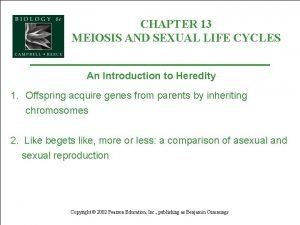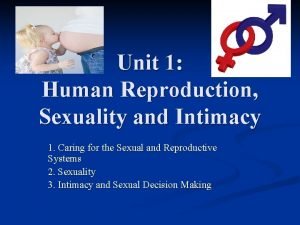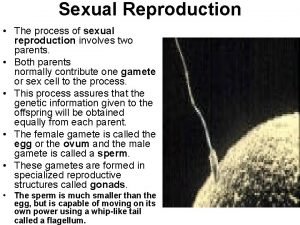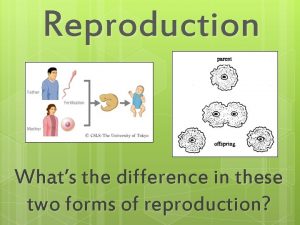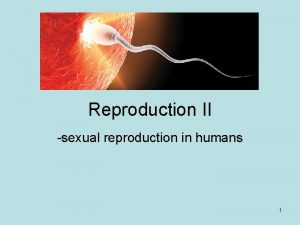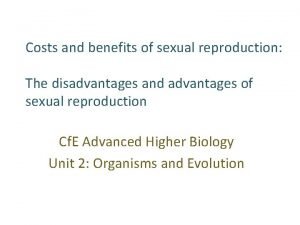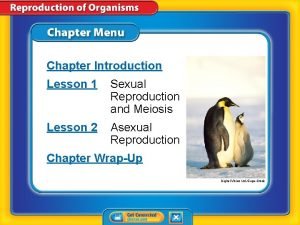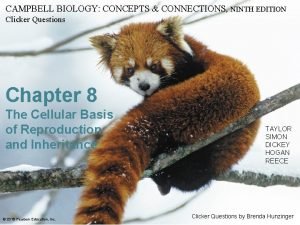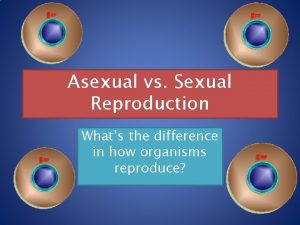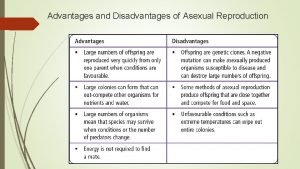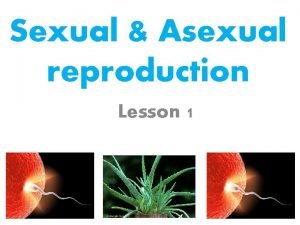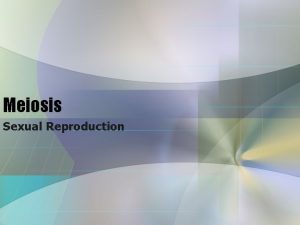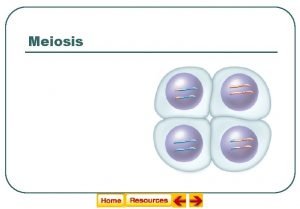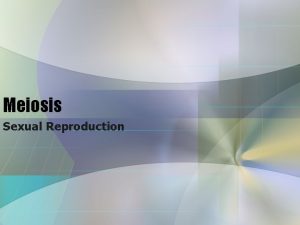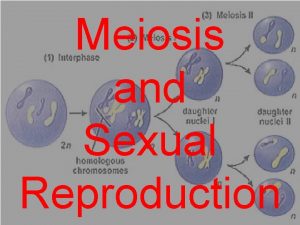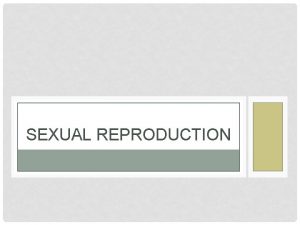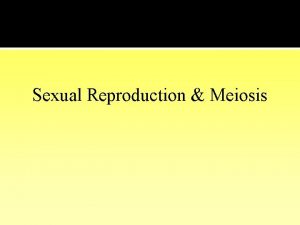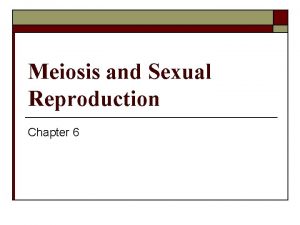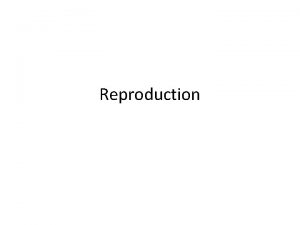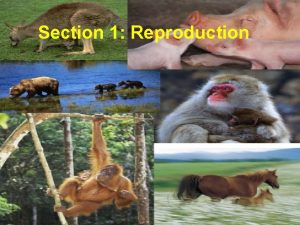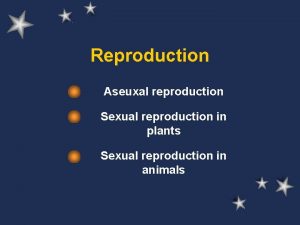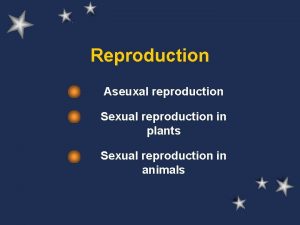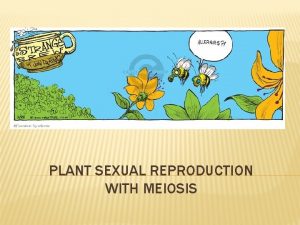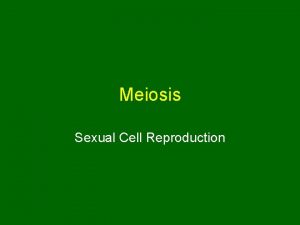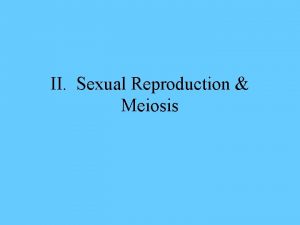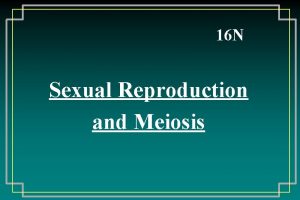MEIOSIS Sexual Reproduction Chapter 6 MEIOSIS IS THE























- Slides: 23

MEIOSIS Sexual Reproduction – Chapter 6

MEIOSIS IS THE BASIS OF SEXUAL REPRODUCTION • Sexual reproduction, through the shuffling of DNA, produces genetic diversity. • This variation offspring produces individuals that may have advantages over one another.

MEIOSIS IS THE BASIS OF SEXUAL REPRODUCTION • Sexual reproduction requires two parents. • Each parent passes on HALF its genes to its offspring. • Must have male and female: male to produce sperm and female to produce eggs.

Cell Division and Chromosome Number • If an organism is the result of sexual reproduction, it will have 2 sets of chromosomes. • One set comes from the mother and one set comes from the father. • These two sets are called homologous chromosomes. • Homologous chromosomes carry the same genes, but they may have different expressions of that gene.

Chromosome Number • Normal body cells have a diploid chromosome number • Diploid means there are two of each kind of chromosome in each cell 2 ” i x “d i f e r P • They occur in pairs • “n” is the number of different chromosomes an organism has, so diploid is represented as 2 n • Humans are 2 n (aka diploid) because we have 2 of each kind of chromosome. Sex determining chromosomes in humans are the 23 rd pair: XX = biologically born female (X from mother, X from father) XY = biologically born male (X from mother, Y from father)


Role of Gametes • In humans, the male and female each contribute 23 chromosomes. • When fertilization takes place: • egg (23) + sperm (23) zygote (46) n + n 2 n • The zygote goes on to develop into an embryo, and on into a complete individual. When the time comes, the cycle repeats.

23 chromosomes Role of Gametes are said to be haploid (or n) because they contain only one of each kind of chromosome. 46 chromosomes

Big idea: The cells which produce eggs and the cells which produce sperm are diploid (or 2 n)… So how do the egg and sperm cells get to be haploid (or n)? Meiosis is a process of reduction division in which the number of chromosomes per cell is cut in half through the separation of homologous chromosomes. M s o ei ! ! is

• Occurs in the sex cells only: the egg and sperm. • Purpose is to reduce the chromosome number of the egg and sperm by half. Meiosis • Like mitosis, meiosis is preceded by the replication of chromosomes. • Unlike mitosis, this replication is then followed by two divisions: meiosis I and meiosis II.




The Stages of Meiosis I Interphase The chromosomes replicate. It is similar to chromosome replication of mitosis. Two identical sister chromatids are held together by a centromere. Prophase I Chromosomes shorten and thicken. Each chromosome pairs with its corresponding homologous chromosome to form a tetrad.

• During Prophase I, each pair of chromatids lines up next to its homologue • This pairing of homologous chromosomes produces tetrads. • A tetrad consists of 4 chromatids This process is called crossing over • Crossing over is the exchange of genetic information (genes) between segments of homologous chromosomes during meiosis.


The Stages of Meiosis I Interphase The chromosomes replicate. It is similar to chromosome replication of mitosis. Two identical sister chromatids are held together by a centromere. Prophase I Chromosomes shorten and thicken. Each chromosome pairs with its corresponding homologous chromosome to form a tetrad. Metaphase I Tetrads line up at the center of the cell. Anaphase I The tetrads break apart and the pairs move to opposite sides of the cell. Sister chromatids remain attached at their centromeres. Telophase I The cell separates into two cells Meiosis I results in 2 haploid (1 N) daughter cells Each daughter cell has half the number of chromosomes as the original cell.

The Stages of Meiosis II Telophase I Prophase II Metaphase II The pairs of sister chromatids start toward the center. Pairs of sister chromatids line up at the center. Anaphase II The pairs of sister chromatids separate and move to opposite sides of the cell. Telophase II (and cytokinesis) Results in 4 new cells that are 1 N.

The Importance of Meiosis 1 (2 n) cell -------> 4 (1 n) cells The offspring will receive a new combination of genetic information. This leads to variation (called independent assortment) in the offspring. Evolution!!




MITOSIS 1. Mitosis occurs in all cells of the body except egg & sperm 2. In mitosis each diploid cell divides once to form 2 cells. 3. In mitosis, each new cell contains the same number of chromosomes as the original cell. 4. In mitosis, the homologous pairs do not come together to form tetrads. There is no crossing over. 5. In mitosis, the new cells contain identical copies. MEIOSIS 1. Me iosis only o ccurs i n the format ion of egg & sperm 2. In m eiosis, each di ploi d cell di vid es tw ice to produce a total of 4 cells. 3. In m eiosis, each of the f our cel l s contai ns half the nu mber of chromosome s as t he parent cell. 4. In m eiosis, the h omolo gous pairs do come together to fo rm te tr ads. Whi le the chromosomes are i n tetrad s, crossing over may occu r. 5. In m eiosis, the f our h aplo id cell s contai n dif fe re nt co mbination s of chromo so mes from each other.
 Sexual and asexual reproduction venn diagram
Sexual and asexual reproduction venn diagram Hare lynx
Hare lynx Asexual vs sexual venn diagram
Asexual vs sexual venn diagram Sexual reproduction and genetics section 1 meiosis
Sexual reproduction and genetics section 1 meiosis Sexual reproduction and genetics section 1 meiosis
Sexual reproduction and genetics section 1 meiosis Chapter 20 sexual reproduction in animals
Chapter 20 sexual reproduction in animals Pedigree miscarriage symbol
Pedigree miscarriage symbol Chapter 10 sexual reproduction and genetics
Chapter 10 sexual reproduction and genetics Metaphase ii
Metaphase ii Chapter 13 meiosis and sexual life cycles
Chapter 13 meiosis and sexual life cycles A sexual reproduction in humans
A sexual reproduction in humans Define reproduction
Define reproduction Define sexual reproduction
Define sexual reproduction Whats reproduction
Whats reproduction Reproduction in humans
Reproduction in humans Sexual or asexual reproduction
Sexual or asexual reproduction Reproduction of organisms
Reproduction of organisms Mitosis sexual reproduction
Mitosis sexual reproduction Connecting the concepts sexual reproduction
Connecting the concepts sexual reproduction Whats sexual reproduction
Whats sexual reproduction Are chickens asexual animals
Are chickens asexual animals Disadvantages of sexual reproduction
Disadvantages of sexual reproduction Difference of sexual and asexual reproduction
Difference of sexual and asexual reproduction Significance of sexual reproduction
Significance of sexual reproduction









